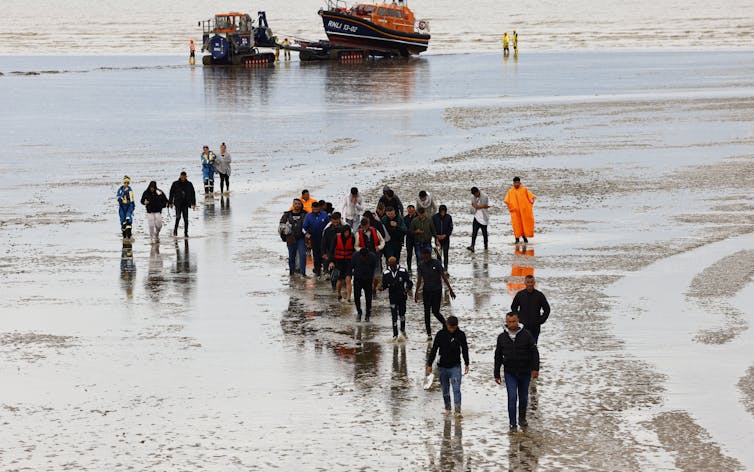A migration “hurricane” is coming, Suella Braverman has warned. Speaking at the Conservative party conference, the home secretary claimed that without action by the Conservatives, millions more people will come to Britain, “uncontrolled and unmanageable”.
The idea that there is a “right” amount of migration has a long history in Britain, despite not being very helpful as a metric. But let’s play along, as it’s clear that migration and asylum – largely discussed in terms of numbers of small boat arrivals – will be a major campaigning focus ahead of the next election.
The reality is that, compared to our European neighbours, the UK does not currently take a fair share of asylum seekers.
Home Office statistics released in June 2023 reported that in the past year, the UK received the 6th largest number of asylum applicants in the EU and UK. But when measured per head of population, the UK ranks 21st – taking just under 10% of the total number of asylum seekers received in the EU and UK.
This is despite the fact that, in 2022, the UK received more asylum applicants than it has in 20 years. Asylum applications in the UK peaked at 84,130 in 2002, falling sharply to 17,916 in 2010 and fluctuating between about 20,000 and 40,000 for the following decade.
The European migration “crisis” – referring to the increase in arrivals of refugees into Europe in 2015 – largely passed the UK by. The UK received 39,720 applicants in 2015 and 39,240 in 2016, accounting for just 3.3% and 3.4% of all asylum applications in the EU during those two years. Germany, which had the most applications in the EU, received 441,805 and 722,270 respectively.
Why applications have risen
Arrivals to the UK and Europe generally in 2022 were due to increased political instability, particularly in Afghanistan, Syria and Eritrea. The most significant difference for the UK was the higher number of applications from Albanians, which was not reflected across the EU – possibly because Albanians can travel visa free for 90 days in the EU.
But it is not simply an increase in asylum applications that has affected the UK.
As applications have risen, the speed at which officials have made decisions on applications has declined. This has been true every year since 2011, leading to the current backlog of asylum applicants. The most recent count is that 138,000 people are awaiting a decision.
There are another 41,200 people whose applications have been rejected and are waiting to be removed from the UK. The number of removals of rejected asylum seekers has also fallen.
UK asylum applications with a positive decision, 2004-2021
Although decisions are taking longer, a greater proportion of them are positive. In 2021, 77% of all decisions resulted in a grant of asylum, after all appeals. This is a new high, up from only 27% in 2004. In every year since 2012, more than half of all applications for asylum have resulted in applicants being granted refugee status.
In addition to seeking asylum, refugees may arrive in the UK through resettlement and other country-specific schemes. Between 2014 and June 2023, 51,000 people arrived through these schemes, mostly from Syria and Afghanistan. A further 179,000 Ukrainians have arrived and in 2022, an estimated 52,000 British National (Overseas) visa holders arrived from Hong Kong.

The need for safe and legal routes
By most measures, the current government is the most aggressively anti-refugee administration in British history. They have passed laws threatening to send asylum seekers to Rwanda, and have stuck them on a barge.
The language ministers use to discuss refugees has been linked with increasing hate crime towards refugees. And their landmark piece of legislation, the Illegal Migration Act 2023, is widely considered to breach the UK’s international legal obligations by organisations such as UNHCR.
But despite appearing tough on borders, this government has recognised a greater proportion of asylum seekers as refugees than any previous administration. It has also enacted the largest refugee support scheme in UK history with Homes for Ukraine and the Ukraine Family Scheme.
In addition to these, there are a significant number of people from Hong Kong and Afghanistan currently arriving through specially designed schemes outside the asylum system. Such programmes demonstrate an important direction for future policy – even the current government recognises the need for safe and legal routes for vulnerable people to reach the UK.
Michael Collyer receives funding from the Economic and Social Research Council. He is chair of Sanctuary on Sea, Brighton's City of Sanctuary group. He is also (voluntary) chair of the Independent Advisory Group on Country Information.
This article was originally published on The Conversation. Read the original article.







